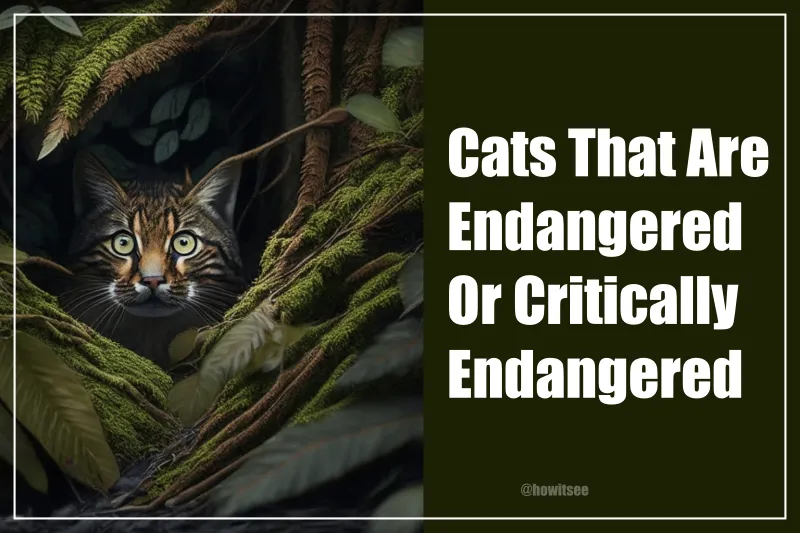Cats are the domesticated species in the family Felidae, and there are about 60 known cat breeds worldwide. In 2022, many animal species are already extinct, and some have come under endangered or critically endangered species, according to the IUCN list.
Hence, in this post, we will discuss the list of wild cats that are Endangered or Critically Endangered based on their latest Conservation status by IUCN.
In addition, many cat species that are categorized under endangered or critically endangered categories by other sources are actually extinct or come in the vulnerable status according to the current International Union for Conservation of Nature (IUCN) list. Therefore, here we have provided you with the latest status.
In advance, we have also discussed the list of other endangered and most endangered Feline species. From the Malayan tiger to Balkan Lynx, more than 20 Feline species are threatened, and some of them are possibly extinct in the wild. So, let’s take a near-up view of some of these unique cat families, highlighting their individual circumstances.
| Critically Endangered Feline Species | Endangered Feline Species |
|---|---|
| Balkan Lynx | Flat-Headed Cat |
| West African lion | Borneo Bay Cat |
| South China tiger | Andean Mountain Cat |
| Sumatran tiger | Iberian Lynx |
| Amur leopard | Javan leopard |
| Arabian leopard | Central Asian leopard |
| Asiatic cheetah | North Persian leopard, Persian leopard |
| Malayan tiger | West Asian leopard |
| Indochinese Leopard | Asiatic lion |
| Northwest African Cheetah | Amur tiger |
| Scottish Wildcat | Indochinese tiger |
| Iriomote Cat | Bengal tiger |
| Bornean Clouded Leopard | |
| Sumatran Clouded Leopard |
Cats that are Endangered or Critically Endangered
1) Iriomote Cat
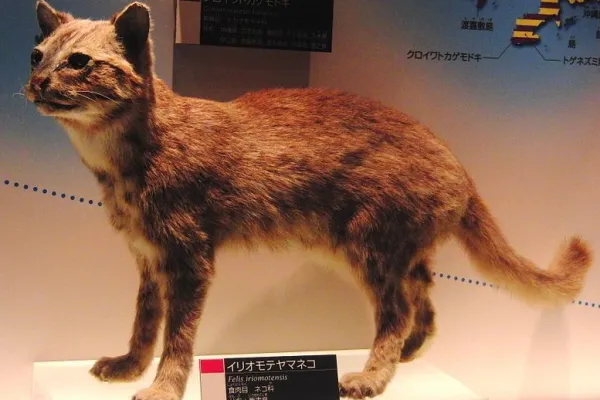
Iriomote cats are only on the small Japanese island of Iriomote and have been listed as critically endangered on the IUCN Red List since 2008.
At that time, there were nearly 250 adult individuals counted, but according to recent data from the Felidae Conservation Fund, the population of Iriomate cats declined to 100 individuals or maybe less.
These cats are native to 292 square km of Iriomote islands with very few subtropical evergreen forests. Also, the main reason behind their declining population is the too much engagement of the human population on the island through tourism.
Iriomote cats are also protected under appendix II of the Convention on International Trade in Endangered Species (CITES).
However, still, it’s not enough to save these marked brown cats with a short tail. The basic diet of Iriomote cats is small animals like fruit bats, birds, wild pigs, rodents, reptiles, amphibians, crabs, and fish.
- Scientific Name: Prionailurus bengalensis iriomotensis
- Status: Critically Endangered, most likely Extinct in the Wild
- Population Size: 100 or less
- Population Trend: Decreasing
- Location: Iriomote Islands (Japan)
2) Scottish Wildcat
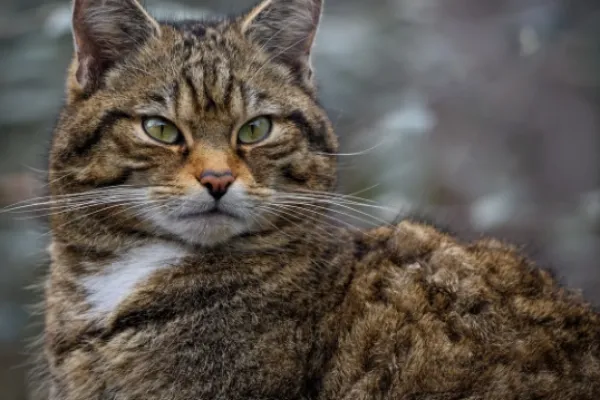
In the past, Scottish wildcats were distributed all along Britain, but after the 19th century, due to the increase in farming and agriculture, the population of these cats declined drastically. And they were lost from England, Wales, and southern Scotland in the 20th century.
Now they are only found in the northern mountain region. According to The Mammal Society’s Population and Conservation Status of British Mammals, commissioned by Natural England, Natural Resources Wales, and Scottish Natural Heritage, the population of wildcats is less than 200.
However, the numbers can be varied to zero if we take actual Scottish wildcats without any domestic cat ancestry hybridization.
Hybridization was also one of the most common reasons behind the decrease in the population of Scottish wildcats. It is difficult to identify a pure wildcat.
Currently, Scottish wildcats are listed as critically endangered on the IUCN Red List and protected under appendix II of the Convention on International Trade in Endangered Species (CITES).
- Scientific Name: Felis silvestris silvestris
- Status: Critically Endangered, most likely Extinct in the Wild
- Population Size: 30-430
- Population Trend: Decreasing
- Location: northern and eastern Scotland
3) Flat-Headed Cat
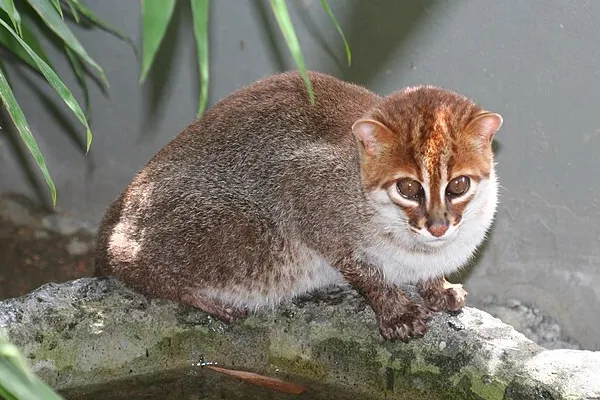
Flat-Headed Cat is a very small wildcat distributed in the Southeast Asia subcontinent. In the past, they were commonly found in the forest of Malaysia and Indonesia.
However, due to the increase in farming and agriculture, especially oil palm plantations, a rapid loss of this habitat is seen. More than 70% of their historical habitat is converted into cropland or places of tourism.
Also, the toxic water pollution from agricultural land leads to snaring and poisoning of these small cats. Flat-Headed Cats are declining at a fast rate, and there is a high probability that today their population size will decrease to under 100 adults.
Even the World Conservation Union has categorized Flat-headed cats under the highest conservation priority of any of the small South East Asian wild cats.
However, researchers still do not get the exact number of flat-headed cats to classify them under critically endangered status on the IUCN Red List.
- Scientific Name: Prionailurus planiceps
- Status: Endangered
- Population Size: 250-2500
- Population Trend: Decreasing
- Location: Thai-Malay Peninsula, Borneo, and Sumatra
4) Borneo Bay Cat
Another rare cat with a decreasing population trend is Borneo Bay Cat. These cats are only found on Borneo Island (Indonesia). Similar to Flat-Headed Cats, deforestation (for oil plantation) and other involvement of human activities like trapping and farming are the main reasons behind the declination of Borneo Bay Cat.
These cats have been listed as endangered on the IUCN Red List since 2002. It clearly indicates how much their population would have decreased in today’s time.
There is a high possibility that these cats can be categorized as critically endangered or near extinction from the wild in 2022. Borneo Bay Cats are one of the most mysterious cats that have been very less studied.
They can weigh around 3-4 kg (6-9 lbs), and their head-to-body length varies from 49.5–67 cm (19.5–26.4 inches). Presently, the government has prohibited any kind of trade or hunting of Borneo Bay Cat in Kalimantan, Sabah, and Sarawak under CITES Appendix II.
- Scientific name: Catopuma badia
- Status: Endangered
- Population Size: less than 2500
- Population Trend: Decreasing
- Location: Borneo Island (Indonesia)
5) Andean Mountain Cat
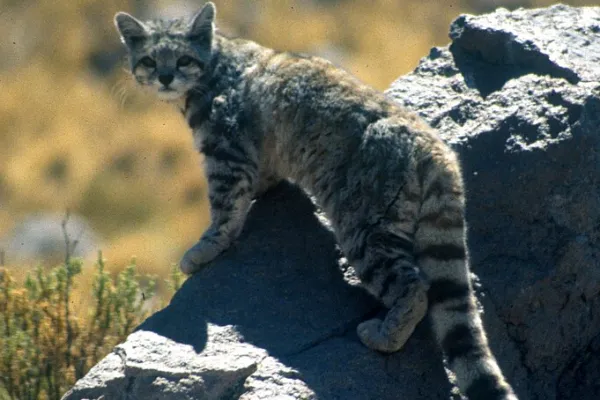
The next one on our list of “Endangered Cats” is Andean Mountain Cats which are native to Andes Mountains in South America. The main reason behind their population is still yet to unveil.
But according to various researchers, human hunting for different purposes (like for fur, for spiritual ceremonies for food, and for traditional medicine) are the primary threats to these cat species.
The secondary reasons behind the decline of their population are the involvement of human activity, loss of habitat, and prey reduction.
Mountain viscachas, mountain chinchilla, rabbits, and small mammals are the primary diet of the Andean Mountain Cat. The approximate height of these cats is 36 cm, and they weigh around 4 to 6 kg (8 to 13 lbs). Currently, Andean Mountain Cats are listed as endangered on the IUCN Red List.
- Scientific name: Leopardus jacobita
- Status: Endangered
- Population Size: less than 1,500
- Population Trend: Decreasing
- Location: Andes Mountains (South America)
Other Critically Endangered Feline Species
- Balkan Lynx (Lynx lynx balcanicus)
- West African lion (Panthera leo senegalensis)
- South China tiger (Panthera tigris ssp. Amoyensis)
- Sumatran tiger (Panthera tigris ssp. sumatrae)
- Amur leopard (Panthera pardus ssp. orientalis)
- Arabian leopard (Panthera pardus ssp. nimr)
- Asiatic cheetah (Acinonyx jubatus venaticus)
- Malayan tiger (Panthera tigris ssp. jacksoni)
- Indochinese Leopard (Panthera pardus delacouri)
- Northwest African Cheetah (Acinonyx jubatus hecki)
Other Endangered Feline Species (Big Cats)
- Iberian Lynx (Lynx pardinus)
- Javan leopard (Panthera pardus ssp. melas)
- Central Asian leopard (Panthera pardus tulliana)
- North Persian leopard, Persian leopard (Panthera pardus tulliana),
- West Asian leopard (Panthera pardus ssp. saxicolor)
- Asiatic lion (Panthero leo ssp. Persica)
- Amur tiger (Panthera tigris ssp. altaica)
- Indochinese tiger (Panthera tigris ssp. corbetti)
- Bengal tiger (Panthera tigris ssp. tigris)
- Bornean Clouded Leopard (Neofelis diardi borneensis)
- Sumatran Clouded Leopard (Neofelis diardi diardi)
In 2023, the conservation status of several cat species hangs in the balance, with some teetering on the brink of extinction. The plight of these endangered and critically endangered felines is a stark reminder of the urgent need for global conservation efforts.
With shrinking habitats, poaching, and human-wildlife conflicts, these magnificent creatures face an uncertain future. However, their uncertain fate also serves as a wake-up call for humanity to take action.
By bolstering conservation initiatives, strengthening legislation against illegal wildlife trade, and promoting sustainable coexistence, we can still turn the tide.
Preserving the world’s biodiversity, including these endangered cats, is not only a moral imperative but also vital for maintaining the delicate balance of our planet’s ecosystems. The time to act is now.
Here, we end our article on “Cats that are Endangered or Critically Endangered” We hope you like this post. We will be back with another article. Till then, stay tuned with us.
References:
- https://www.pumapix.com/most-endangered-cats-in-the-world/
- https://www.iucnredlist.org/
- https://felidaefund.org/learn/cats/iriomote-cat
- https://wildcatconservation.org/wild-cats/asia/flat-headed-cat/
- https://animalia.bio/critically-endangered-cr?page=1
- Wikipedia
Also Read:

Meet Abhidept (nickname Monty), the visionary founder of How It See, being an engineering student, he’s fueled by an insatiable curiosity about the world around him. He is captivated by an eclectic correlation between animal groups, science, and nature, and this fascination drives his quest for understanding.
After completing his degree, he’s set on a mission to delve deep into the realm of nature, accumulating knowledge to share with you through his writing. In the meantime, he loves to watch anime and read anime.
